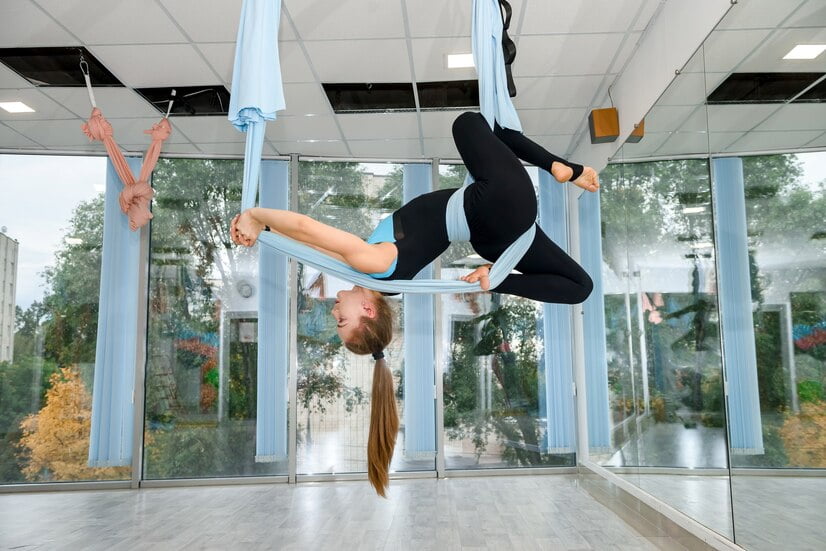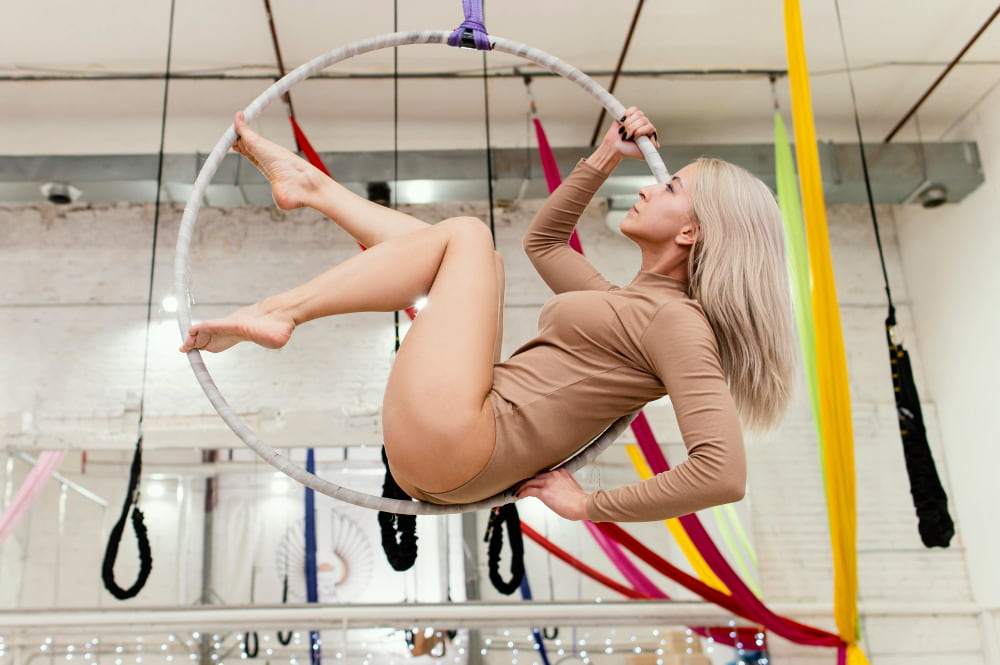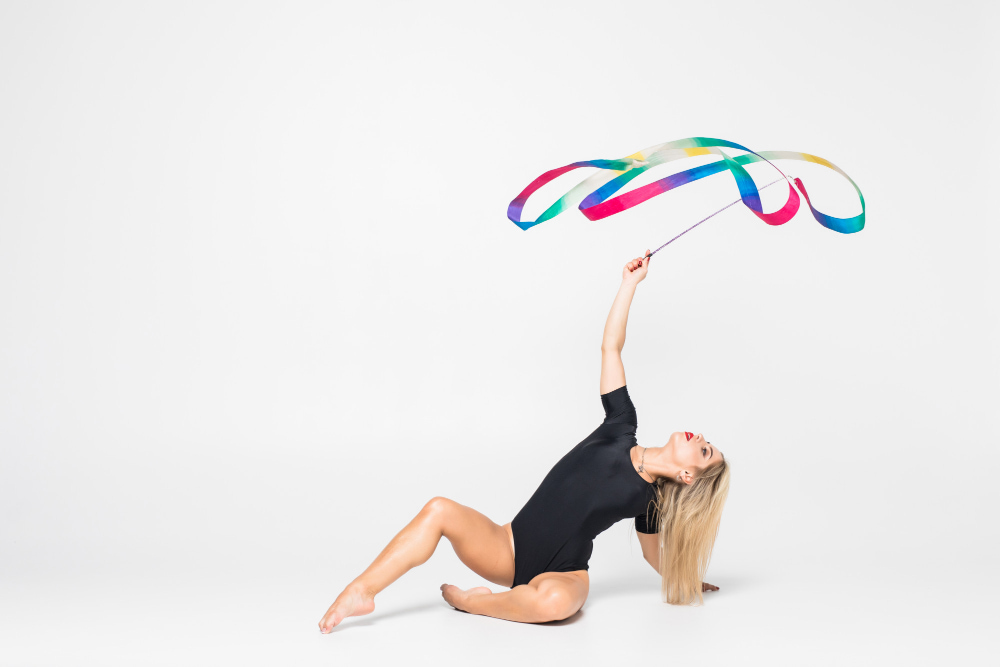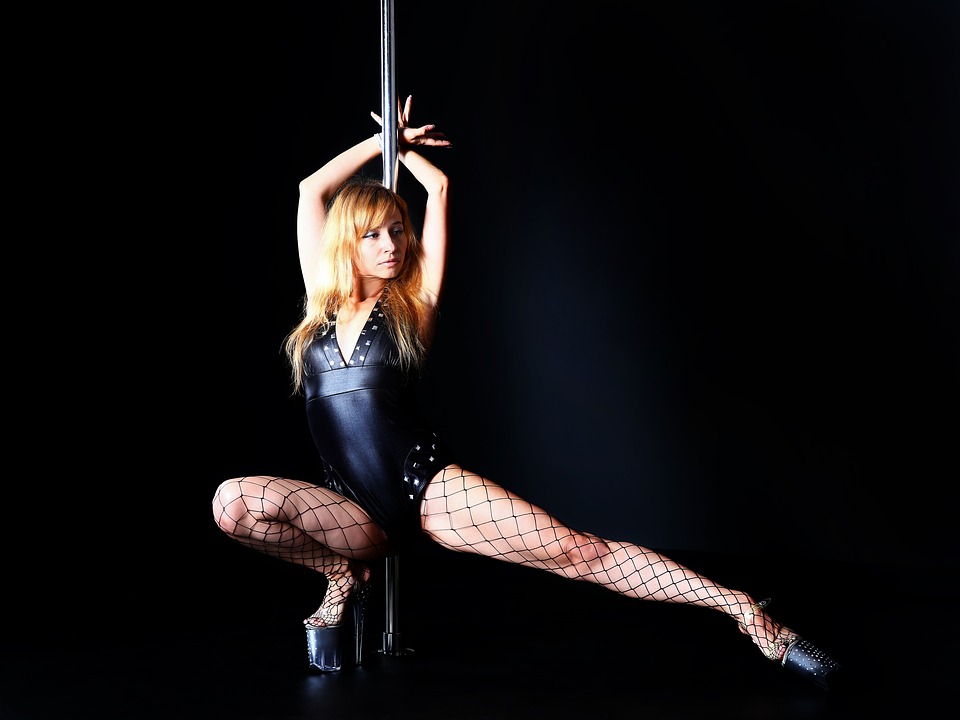
Summary
The Wonders of Aerial Dance: Types and Techniques
Aerial dance, a discipline that combines acrobatics and dance, is increasingly intriguing. Would you like to discover this unique practice? This article is for you.
Summary
Introduction to Aerial Dance
Whether you are attracted to aerial silks, hoops or hammocks, here you will learn the basics of each type of aerial dance, step by step. You will also discover the physical and mental benefits that this discipline offers.
Aerial dance, a discipline at the crossroads between art and acrobatics, offers a unique experience to those who practice it. Imagine yourself suspended in the air, performing graceful movements while defying the laws of gravity. It is this mix of dance and aerial performances that attracts more and more followers, looking for a new way to explore their body and their creativity.
This form of dance is distinguished by the use of suspended apparatus, such as fabrics, hoops, a pole dance bar or hammocks, allowing dancers to move in three dimensions. Each movement, each figure, then becomes an artistic expression in its own right, adding a spectacular visual dimension to the performance, often practiced in circus art. Whether you are attracted by the aesthetics, the physical challenge or simply the novelty, aerial dance offers an extraordinary adventure, where you learn to rise above the ground, both literally and figuratively.
The Different Types of Aerial Dance
Aerial dance comes in several fascinating disciplines, each with its own unique techniques and challenges. Learning to master these disciplines requires following specific steps to ensure your safety and maximize your progress. Here's how you can get started with these different types of aerial dance, step by step.
Aerial Fabric Dance
The aerial fabric is one of the most popular aerial dance apparatuses, offering a multitude of possibilities to create elegant and dynamic figures. To get started, follow these steps:
- Climb into the fabric : Stand under the fabric with your feet hip-width apart. Grasp both ends of the fabric and pull them down firmly. Use your arm strength to pull yourself up into the air, bending your elbows and using a pulling motion.
- Make a roll : Once in the air, place the fabric around one of your legs, wrapping it several times. This will give you extra stability and allow you to maintain a suspended pose.
- Perform a controlled descent : To come back down, gently unfold the fabric around your leg while maintaining constant control over your speed. Slowly lower yourself back down to the ground, keeping your body aligned and stable.
- Basic figures : Once you're comfortable with the ups and downs, try simple figures like the star (extending your arms and legs to create a suspended star shape) or the "footlock," where you lock the fabric around your feet to stabilize a pose.
Aerial Hoop (Lyra)
THE aerial hoop, or Lyra, is a suspended metal circle that allows for circular movements and fluid transitions. Here's how to get started:
- Climb the hoop : Hold the hoop in both hands and begin to swing your body slightly to create momentum. Use this momentum to jump and put one leg through the hoop, then sit down in it.
- Perform rotations : Once seated in the hoop, you can begin to rotate using your hips to guide the movement. Keep your body centered to maintain balance.
- Smooth transitions : To move from one pose to another, use the hoop handles to lift yourself up or bend over. For example, from a seated position, push with your legs to pull yourself up to a standing position inside the hoop.
- Basic figures : Try tricks like the “man in the moon” (where you lie on your back inside the hoop) or hanging splits, which highlight your flexibility.
Aerial Hammock
THE aerial hammock is often used for flowing movements and deep stretches, perfect for a gentle start.
- Enter the hammock : Sit in the hammock like a swing. Pull on the fabric with your hands to make sure you are centered and stable.
- Inverted positions : To switch to an inverted position, lean back while holding the edges of the hammock. Gently let yourself rock until your head is down and your legs are in the air. Make sure the fabric supports your back and hips.
- Swings : Once comfortable in the hammock, begin to gently rock back and forth. Use your breathing to synchronize your movements and create a natural flow.
- Stretching : The hammock is great for stretching. Try positions like the butterfly, where you cross your legs while stretching your back, or the frog position, where you open your hips using the support of the hammock.
Vertical Dance
There vertical dance uses a harness to suspend the dancer against a wall, transforming vertical surfaces into dance stages.
- Put on the harness : Put on the harness, making sure it fits properly. The harness should be attached to a secure anchor point above you.
- Walk on the wall : Start by moving away from the wall, keeping your body inclined. Then, push with your feet to start walking on the wall as if it were the floor. Keep constant pressure on the feet and a straight line with your body.
- Abseiling : To descend, lean back while maintaining slight tension on the harness. Use your legs to control the speed of the descent.
- Pendulum movements : Once you have mastered walking and descending, try pendulum movements. Swing from side to side using the wall as a point of contact to create large, dynamic movements.

How to Start Aerial Dance
Getting started with aerial dance can seem intimidating at first, but with the right steps and a little preparation, this journey into the air becomes a rewarding and accessible experience. Whether you’re drawn to the physical challenge or the artistic expression, here’s how you can get started safely and confidently.
Choosing the Right Equipment
Choosing the right equipment is crucial to getting started in aerial dance. Depending on the type of dance that attracts you, you will have to choose between aerial silks, hoops (Lyra), or hammocks. The aerial fabric suitable for those looking for a wide variety of movements and figures, while the aerial hoop offers a more structured experience with solid support for rotations and poses. The aerial hammock, on the other hand, is ideal for those who prefer a gentle approach, with an emphasis on fluidity and flexibility.
Proper installation of the apparatus is essential to ensure your safety. It is essential to check that the equipment is securely anchored to a structure capable of supporting your weight and that the fabrics or hoops are in good condition. Do not neglect the quality of the materials and invest in professional equipment to avoid any risk of accident.
Basic Techniques for Beginners
Before you jump into complex tricks, it is important to master the basic techniques. This starts with learning the safety positions, which will allow you to stabilize yourself on the apparatus without risking falling. Next, you will need to familiarize yourself with simple movements, such as fabric windings where the hoop mounted, which will help you understand how your body interacts with the equipment.
Aerial dance also requires a good dose of physical force and of flexibility. Strengthening exercises for your arms, abs and back are essential to support your body while suspended. At the same time, incorporating regular stretching into your routine will help you gain flexibility, which is crucial for performing certain figures.
Safety and Injury Prevention
Safety should always be your priority when aerial dancing. Never practice alone, especially when you are starting out. Always make sure that a qualified person is present to guide you and intervene if necessary. Also equip yourself with a safety mat to cushion any falls.
The most common injuries among beginners are often related to poor technique or insufficient physical preparation. To avoid them, warm up carefully before each session, paying particular attention to your joints and muscles. Learn to listen to your body: if a position or movement causes pain, stop immediately and reassess your technique.
Finally, remember that progression in aerial dance must be progressive. Don't try to rush things. Take the time to master each movement before moving on to the next one. This patience will not only help you avoid injuries, but also build a solid foundation for progressing in this demanding discipline.
Benefits of Aerial Dance
Aerial dance is not only an impressive artistic discipline, it also offers a multitude of physical and mental benefits that contribute to well-being. Whether you are looking to improve your fitness or explore a new form of expression, aerial dance has a lot to offer.
Improved Muscle Strength and Flexibility
One of the first benefits that you notice when practicing aerial dance is the significant improvement in Muscular force. Each movement requires intense muscle involvement, especially those in the upper body, such as the arms, shoulders, and abs. Holding suspended positions or performing complex tricks requires considerable strength, which you develop as you practice.
At the same time, aerial dance is a great way to improve your flexibility. Apparatus, such as a fabric or hammock, allow you to deepen your stretches using your body weight and gravity. This combination of muscle strengthening and flexibility work creates a perfect balance, sculpting a strong and agile body.
Developing Self-Confidence and Creativity
Beyond the physical benefits, aerial dance plays a crucial role in the development of self-confidence. The simple act of getting up in the air, mastering your body and performing movements that seem impossible at first, builds confidence in your abilities. Each new trick you successfully perform is a personal victory that boosts your self-esteem and confidence, both on the apparatus and in everyday life.
Aerial dance is also a great source of creativity. Every movement can be reinvented, every sequence modified to create a unique performance. Interaction with the apparatus opens up endless possibilities to express emotions and tell stories through movement. This artistic freedom is a powerful means of personal exploration, allowing everyone to develop their own style and let their imagination run wild.

Conclusion
Aerial dance is a fascinating discipline that combines strength, flexibility and creativity. It offers several types of practices, adapted to different levels and preferences. Whether you are drawn to the fabric, the hoop or the hammock, each option brings unique challenges and physical benefits.
By starting correctly, with the right equipment and techniques, you can progress safely. Regular practice builds self-confidence and opens up endless possibilities for artistic expression. Safety should always be a priority to avoid injuries.
Try dancing the DECIBEL way
If you are looking to combine dance and cardio, DECIBEL® is perfect for you! Join our 45-minute sessions where fitness and dance come together to improve your endurance and tone your body.
Dive into dynamic choreographies in a friendly atmosphere. Our passionate coaches will guide you to sculpt your abs, thighs, and glutes, all in a vibrant atmosphere, with lively music and soothing lights.
At DECIBEL®, fun is guaranteed! Book your spot in our studio in Beaubourg now!
Read also
follow us
on instagram
Follow our news,
take advantage of our tutorials and participate to our
contests!
BREAKING NEWS!
Receive our newsletter.






